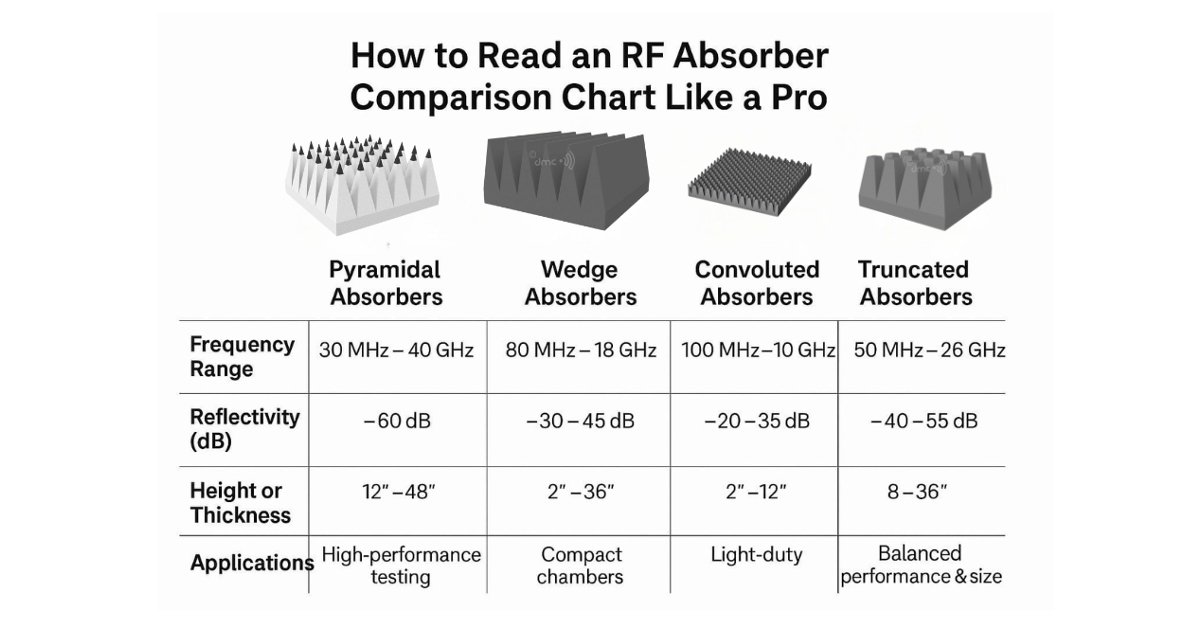RF (radio frequency) absorbers might be intimidating at first when you hear about them. But if you know what to compare, it’s a piece of cake. In this blog, DMC will teach you how to read an RF absorber comparison like a pro. We’ll discuss four significant types: pyramidal, wedge, convoluted, and truncated absorbers.
What Are RF Absorbers?
RF absorbers are materials that filter out or eliminate unwanted radio signals. These bounce off chamber test rooms or walls. RF absorbers intercept those and do not reflect.
At DMC, we use RF absorbers to install in:
- EMC test chambers
- Anechoic chambers
- Radar systems
- Communication laboratories
Why Compare RF Absorbers?
Not all RF absorbers are equal. They all differ in shape, size, and performance level. Comparing them to one another makes it easy for you to select the best according to your requirements. A good comparison illustrates
- Range of frequency
- Level of reflectivity (how much it absorbs)
- Dimensions and shape
- Level of durability
-
Pyramidal Absorbers
These are the most widely used and best-known absorbers. They come in tall pyramid shapes and are commonly found in DMC anechoic setups.
Characteristics:
- Ideal for wide range of frequencies
- Good signal absorption performance
- Used in full anechoic chambers
Advantages:
- Excellent absorption
- Good for testing at high frequencies
- Even performance
Cons:
- Large in size
- Takes up more space
-
Wedge Absorbers
Wedge absorbers are like thin, extended triangles. The bottom is thick, and the top is a point.
Characteristics:
- Target single frequency bands
- Usually mounted in sidewalls or sections where there is minimal space
Advantages:
- Good for directional absorbing
- Can be installed in corners or narrow spaces
Disadvantages:
- Not ideal for wideband testing
- Lower performance compared to pyramidal types
-
Convoluted Absorbers
These are egg-crate or wavy-shaped absorbers. They appear identical to acoustic foam but are designed specifically for RF. DMC recommends these for low-budget or low-frequency test environments.
Features:
- Light in weight
- Frequently used in pre-compliance test rooms
Benefits:
- Cost-effective
- Easy to install and uninstall
- Suitable for low-frequency ranges
Drawbacks:
- Less accurate than pyramidal or wedge types
- Not ideal for high-end or certified test labs
-
Truncated Absorbers
They are truncated versions of pyramidal absorbers. The tips are cut flat.
Features:
- Lower profile but acceptable performance
- Used for hybrid spaces where space is limited
Pros:
- Conserves space
- Still has good absorption
- Safer (no sharp tips)
Cons:
- marginally less absorption than full pyramidal varieties
- Does not perform as well for very high frequencies

How to Read an RF Absorber Comparison Chart
When viewing a chart comparing these varieties, note:
-
Frequency Range
Every absorber has optimal frequencies at which it performs best. Make sure it covers your needed range.
-
Reflectivity (dB Level)
This indicates how much signal is being absorbed. A lower number (e.g., -40 dB) is preferable.
-
Absorber Height and Size
Verify if the absorber will be able to fit in your room. More costly absorbers are taller and more efficient at absorption.
-
Fire Rating and Material Type
Safety first. Get fire-resistant foam with appropriate ratings.
-
Cost vs. Performance
Match your budget with your need for testing. Don’t spend more on expensive absorbers if all you want to do is small tests.
| Application Type | Best Absorber |
| High-end testing (military, radar) | Pyramidal |
| Compact chambers | Wedge |
| Light-duty or office use | Convoluted |
| Balanced performance and size | Truncated |
Conclusion
It is simple to read an RF absorber comparison chart once you know the basics. Observe shape, frequency range, and reflectivity. Use this to select the correct choice of absorber for your application.
Whether you use pyramidal, wedge, convoluted, or truncated, DMC ensures each option is tailored for optimal performance and reliable test results that will fit perfectly and provide you with improved test results and fewer worries.
Contact DMC today. Let’s see how we can help you achieve the dependable data you require.
Now you’re ready to read those charts like a pro!

